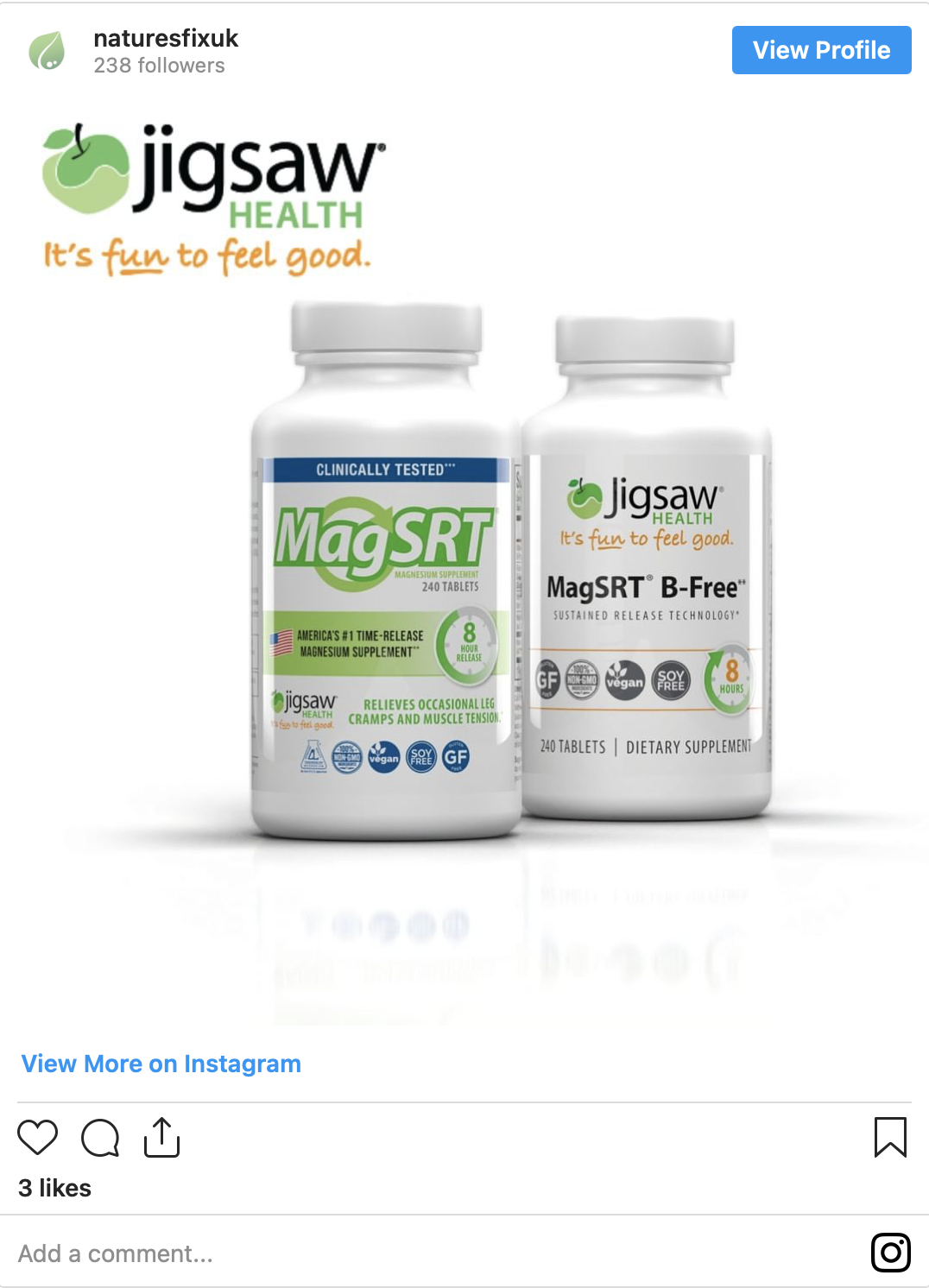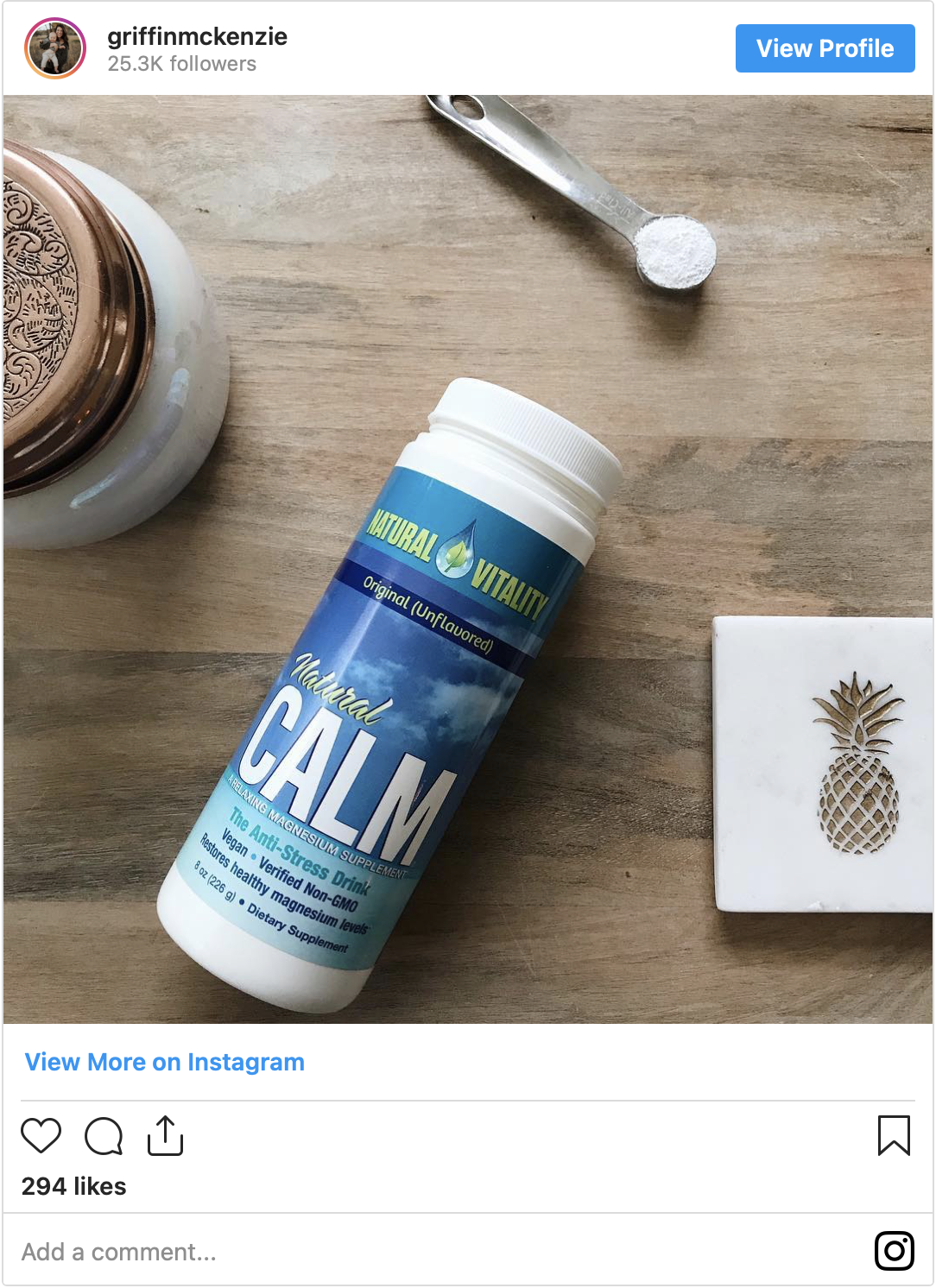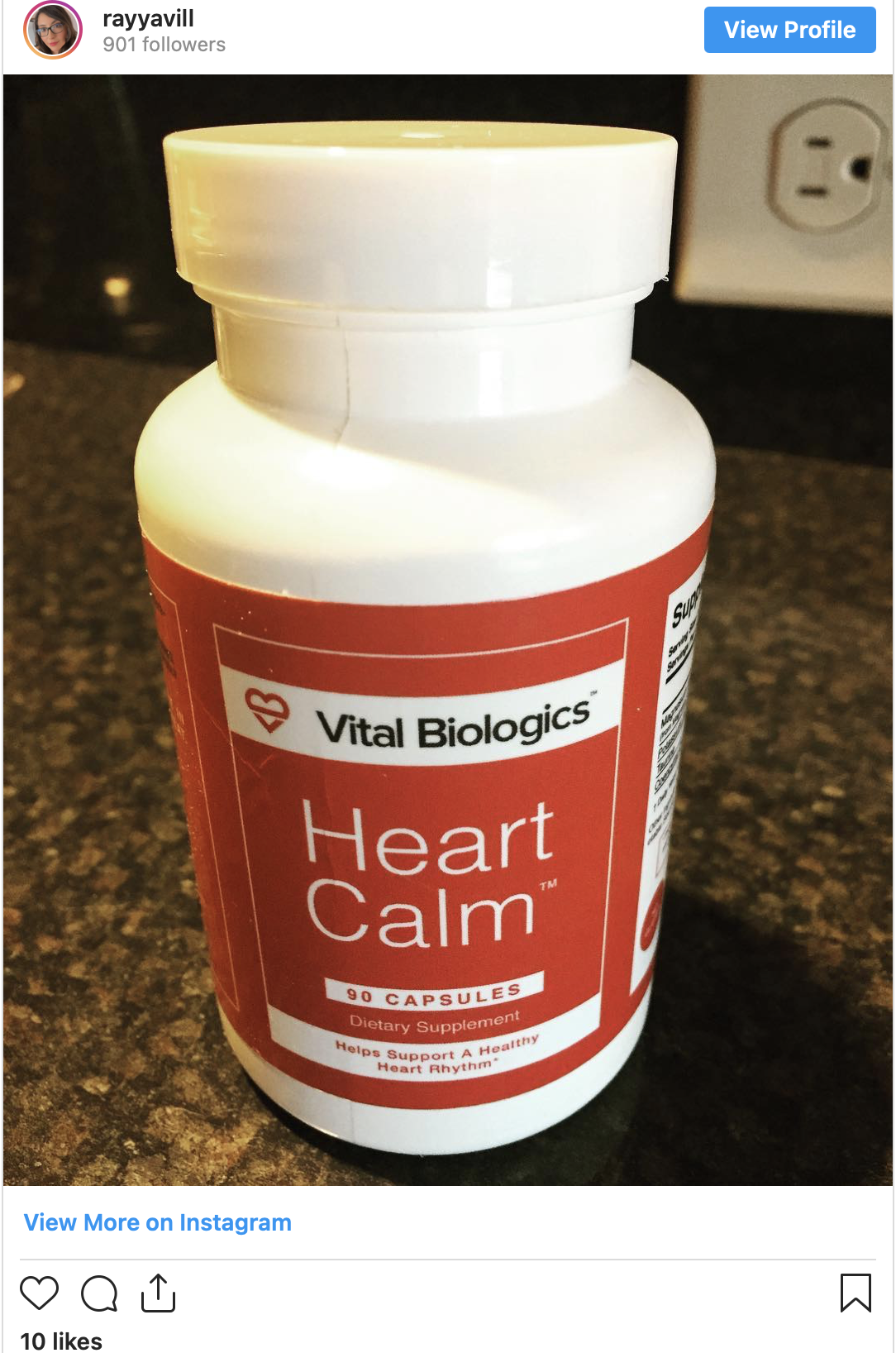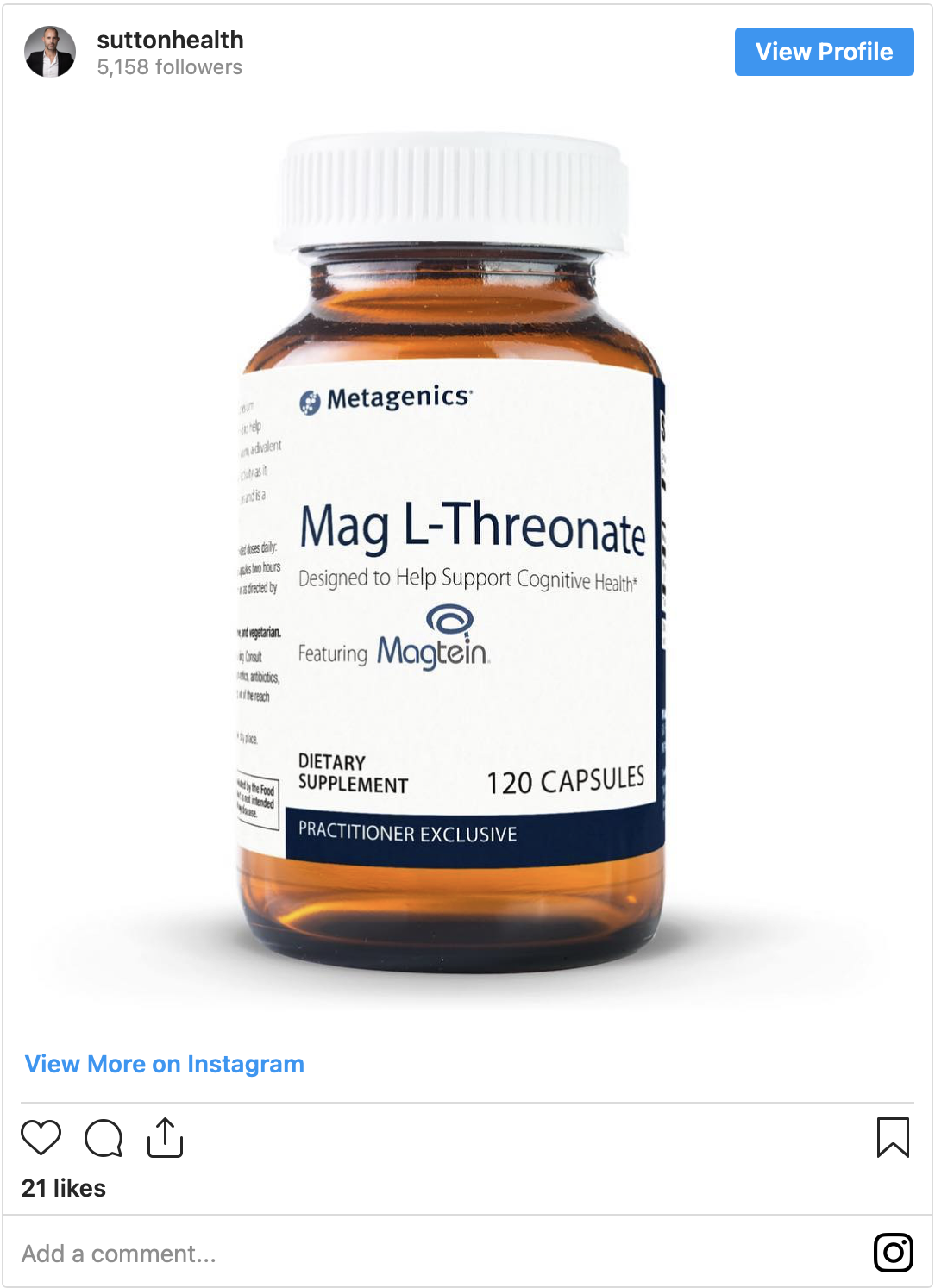Magnesium: The 12th element on the periodic table, the 8th most abundant element in the universe (and 7th most abundant on earth), and a miracle health supplement. I freaking love magnesium.
Why? Well, because for one thing, supplemental magnesium was the first supplement that actually helped me with the rough symptoms of HPA-axis dysregulation.
We’ll get into my story in detail later, but just know that magnesium turned down severe anxiety from a 10 to a 4 — and finally freed me from panic attacks that had forced me to stop working and were bordering on keeping me stuck at home.
The second reason I love magnesium is that it’s one of the easiest things I can recommend for people, no matter what health or performance goal they’re pursuing.
Magnesium works so well because of how important it is for bodily functions, as well as because so many people are deficient in this mineral. Despite being the 7th most abundant element on earth, modern farming practices, as well as other factors, have rendered most people low in this mineral.
Increasing magnesium intake can resolve fitness problems (such as cramping and injury likelihood), prevent or heal heart palpitations and even some arrhythmia, and sooth or erase mood problems ranging from depression and anxiety, and may be a crucial factor in psychosis.
Considering that magnesium has been confirmed to be involved in 300+ enzymatic processes in our biology, and is estimated to be involved in closer to 1000, it’s no wonder that remedying a deficiency could have such a wide breadth of results.
You don’t have to experience panic attacks to get benefits from magnesium.
Common Symptoms of Magnesium Deficiency
Deficiency in this mineral can manifest in a wide variety of symptoms. Here are a few you might experience that could signal that you are low in magnesium:
- Anxiety, depression, & mood problems
- Heart Palpitations & arrhythmias
- Muscle cramps and twitches, especially for athletes
- Migraine and other headaches
- Brain fog & difficulty focusing, ADD, & hyperactivity
- Immune dysfunction and susceptibility to illness
- High susceptibility to injury, especially broken bones
- Slow recovery from exercise
Now, magnesium isn’t a cure for everyone. There are other factors involved other than magnesium deficiency, especially for difficult problems health problems. However, I’ve personally learned not to underestimate the power of this mineral.
Depending on your level of deficiency, the benefits of magnesium can be massive, and even if you don’t notice any of the symptoms I mentioned, you could still notice an improvement from supplementing.
To highlight the power of magnesium, I’m going to give you the first ever walkthrough of my story with chronic disease and how magnesium played an essential role in healing.
Then we’ll move into a section on understanding the role of magnesium in our modern world, cover how to test for magnesium deficiency, and then discover the best form of supplemental magnesium for your purposes.
So, to start things off, a little about your author.
My Story With Magnesium
In 2017, I suffered a massive panic attack, which I thought was either me losing my mind or my heart stopping (and at the time I actually hoped it was the latter, because it felt like the easier option to deal with).
This happened by a result of factors that had been compounding for close to half a year, so we’ll start there.
I’ve been passionate about health and fitness since I was 13 when I started P90X and mixed martial arts. Many years later, in 2016, I decided to become a professional athlete and I started training to compete in the Crossfit games for the title of Fittest on Earth.
Without access to world-class coaches, extensive blood work, and nutritionists, I dove into textbooks on Olympic weightlifting, and podcasts on nutrition. I began biohacking, and I learned a ton about living one’s best life.

However, I wasn’t training for health, but for performance. I hadn’t yet learned about adrenal-fatigue and chronic disease, which often occur following prolonged periods of massive stress to the body or mind.
Common among athletes who train hard and don’t recover, people will often “crash.” Though there is a multitude of names for these conditions, what’s happening basically is that the body and nervous system are shutting down to stop you from working yourself to death.
In my case, after 6 months of training for 4 to 6 hours a day in what is arguably the most physically taxing exercise that exists (Crossfit style HIIT and Olympic weightlifting), I crashed — hard.
I never received a formal diagnosis, mainly due to the crazy expenses of going to a clinician just to have them tell me my blood work was normal and I’m probably just anxious, but I knew I was sick.
I’ve always been a very laid-back person. If living in the woods for 30 days at age 16 or climbing a 300-foot cliff multi-pitch on my first outdoor climbing trip didn’t make me anxious, I knew I wasn’t “just anxious.”
The point is, my body and mind were rebelling against me for pushing them too hard. I was anxious daily; I had panic attacks randomly and often felt like I was losing touch with reality. Then, I began experiencing hot flashes, heart palpitations, tinnitus, and other physical symptoms.
Throughout this time, I began reading countless articles online on sites such as selhacked.com, bengreenfieldfitness.com, and other places to discover anything that could help me start healing
.
I kept seeing magnesium on these lists, and it was always described as an essential mineral that can help with, well, darn near anything.
Dr. Norman Shealy has said that “every known illness is associated with a magnesium deficiency,” and that “magnesium is the most critical mineral required for electrical stability of every cell in the body. A magnesium deficiency may be responsible for more diseases than any other nutrient.”
Still, though I believed the mineral was probably essential for long-term healing, I had doubts it would be powerful enough to aid with my immediate problems.
But after having a panic attack in the parking lot of a gas station not a mile from my house, and having to drive home without even going in to buy something, I knew I had to try something.
I ordered a bottle of topical magnesium lotion, and as soon as it touched my skin, I relaxed.
I still wasn’t fully healed, or anywhere near how I felt before I became sick, but a mere lotion dropped my anxiety from a splintering 10 to a manageable 4, and I didn’t suffer a panic attack again for months. I may not have been dying, but I sure as heck felt like it, and this mineral brought me back to a functional baseline on several occasions.
Look, magnesium isn’t always a cure-all, but it is one of the most reliable, affordable, and effective methods you can try for darn near any health or fitness purpose.
The reason for this is because — as we mentioned in the intro — magnesium is one of the most important minerals for our biology that exists. It is important for almost every bodily function, from a well-working brain to a strong heart.
I’d also like to emphasize that you don’t need to have some kind of crazy disease to benefit from magnesium, and that’s actually not the purpose of this guide (I don’t give medical advice).
I’m far more concerned with boosting your performance. Just think: you may be doing just fine in life, but a simple mineral could boost your performance from an 8 to a 9, reduce your risk of heart attack, improve your exercise recovery, and stabilize your mood.
I don’t know what word you would use to describe such a thing, but I lean towards “miraculous.”
Understanding the Causes of Low Magnesium
So, as I’ve mentioned, the big reason why magnesium is so beneficial for so many people is because most people have low magnesium. At a glance, this is actually surprising, as magnesium is one of the most common minerals on the planets and is a key component in plant life.

Why is this? Well, for one thing, our bodies don’t “hold on” to magnesium. The mineral is typically so available in our diets that our biology has adapted to “release” magnesium very easily to avoid ever having too much magnesium.
This actually makes magnesium one of the safest supplements that exists, since your body simply expels any excess. Our bodies don’t store magnesium like they do calcium, which is “hoarded” due to the lower prevalence in the environment.
And calcium actually brings us to the first major component in magnesium deficiency.
Reason 1: Over-consumption of calcium
For the past 20 years or more, calcium has been promoted as an essential mineral. You know the drill, drink your calcium-enriched milk and get stronger bones.
However, this promotion of calcium overlooked something major: calcium and magnesium act cooperatively to provide benefits throughout the body, and if you don’t have enough magnesium, calcium actually becomes a bad thing. You’re supposed to have a ratio of about 2:1 or 1:1 calcium to magnesium in the body.
We’ve essentially flipped the board, and are consuming a steady supply of calcium which gets stored and our ratios of calcium to magnesium get more and more unbalanced.
If this weren’t enough, we no longer have that steady supply of magnesium for our diets.
Reason 2: Low magnesium in our diet
Vegetables and plants in our diet are typically a major source of magnesium. To shed some light on why, check this out: plant chlorophyll is actually identical to the hemoglobin that makes up our blood, except for one atom: chlorophyll has magnesium (instead of iron).
Unfortunately, modern farming practices have rendered much of the soil used to grow food low in magnesium.

Members of developed countries often have sub-par magnesium levels while those in undeveloped countries have fine levels, and this implies that the refining of food in modern society is a key aspect of the problem. For a great journal article on the subject, check out Magnesium deficiency in plants: An urgent problem.
Furthermore, the animals we eat are also consuming low magnesium plants, so even animal products contain less magnesium than in the past. Even if you eat organic, unless you know the exact farming practices of the farm providing your food, there’s really no way to know if your food has enough magnesium or not.
Reason 3: Ineffective testing for magnesium in modern medicine
The standard test for magnesium is a serum blood test. However, it is so rare for serum magnesium tests to show deficiency that many physicians don’t even do the test, and mistakenly believe that magnesium deficiency is extremely rare.
Here’s the problem: magnesium is so absolutely essential for so many bodily functions — and especially heart function — that your body will pull magnesium from the rest of your body to maintain stable serum blood levels.
If you ever actually show low magnesium on a serum blood test, you are probably experiencing such severe deficiency that your body can’t even stabilize your blood magnesium by pulling from other tissues such as skeletal tissue or organs. If this ever occurs, you are likely in serious trouble.
My point is this: the medical industry typically overlooks one of the most important markers for health because they use an ineffective test. Thankfully, reliable tests for magnesium do exist and can be very affordable.
How to Test for Magnesium Deficiency (If You Want To)
OK, because magnesium deficiency is so common, and magnesium is so safe to use as a supplement, you can start supplementing it without testing if you want to.
However, some people are magnesium wasters, and even with intense supplementation, they will remain deficient. Testing is one of the only ways to discover how your magnesium levels are reacting to supplementation. With that in mind, the first thing we’ll learn is how to test for magnesium properly.
To test for magnesium, instead of the standard serum test, we’ll use the Magnesium RBC Test. This blood test involves actually looking inside our red blood cells and analyzing how much magnesium is present there.
Unlike serum magnesium, which simply measures how much free magnesium is floating in our blood, the magnesium RBC test is more accurate by actually looking inside our cells. “Normal” lab ranges for a magnesium RBC test are considered to be between 4.2 and 6.8mg/dL.
However, Dr. Carolyn Dean, Author of The Magnesium Miracle and an expert I trust on the subject, recommends that you aim to be between 6.0 and 6.5mg/dL.
Her logic is that the values set by most labs are based on national averages, but when 80% or more of the population consumes less than the recommended daily values of magnesium (According to World Health Organization statistics), then “average” is probably too low. For this reason, she has her clients aim for the top of the range.
I want to add another note here: if you get your RBC test and you are in the low end of the normal range, but still display symptoms of magnesium deficiency, then you may still be deficient. People have different needs, and many people benefit massively from raising their RBC magnesium levels to the higher ends of the range — even if their starting point was within the confines of what is considered “normal.”
The most affordable way to get a magnesium RBC test is to have your doctor order it for you under your insurance. Some doctors dislike having their patients bring up special testing, and may think you don’t need to be worried about it. However, many are also willing to listen, and more and more practitioners are learning about the importance of proper magnesium testing.
Fortunately, even if your doctor isn’t interested, you can simply bypass them (and look for a better doctor in the meantime) and get the test directly.
In the U.S., you can go to sites like requestatest.com and order a magnesium RBC test for about $60. Then you simply take the forms they send you to a local lab, and they’ll draw your blood and send you the results just like if your doctor ordered it.
I recommend getting a magnesium RBC test within the first 3 months of supplementing magnesium, and immediately if you either:
- Stop noticing benefits from magnesium, or
- Notice negative side effects.
The reason I recommend testing is because it greatly speeds up the process of discovering your optimal dose. If you want to get more advanced, the best method is to do a magnesium RBC test before starting supplements.
When you get the results, start supplementing, and then after a period of two weeks or a month of supplementing, test again.
Then, you can increase or decrease your magnesium supplementation based on whether your magnesium levels have reached adequate levels.
For example, if you start at a 3, and you want to get to 6.5mg/dL, a good supplement protocol would show an increase in your RBC magnesium test on the second test.
If your second test shows an increase to a 4 or a 5mg/dL, then you could simply stick with your protocol, knowing you will likely reach optimal levels at a steady pace. If on the other hand, you’re already at a 6mg/dL, you can either maintain your protocol or lower your magnesium supplementation a bit.
If you only raise your levels to a 3.4mg/dL, not at all, or your levels decline despite supplementation, then increase your supplementation or consider trying a different form of magnesium (we’ll get into the best types of magnesium in the next section).
Personally, I started supplementing magnesium long before I ever did an RBC test, mainly out of desperation to calm my health issues. After a few months of supplementing magnesium, my health issues started to resurface.
I couldn’t tell if my returning health problems were due to having too much magnesium, or if I was still not getting enough — so to be safe, I stopped taking magnesium.
However, when I got my RBC blood test a few months later, I found that I was still low! I switched to a more bioavailable magnesium supplement at this point and again saw a massive improvement.
You don’t need to test your magnesium, but it massively aids in getting the most out of the supplement. Typically I try to find ways to help people use supplements without doing medical testing, as medical testing is usually really expensive. Most people aren’t in a position to drop $500 just to find out if they should try a nutritional supplement.
However, $60 is a different story. You can get $60 together by forgoing a few coffee shop visits or putting a few TV subscriptions on hold. It’s really quite convenient.
Magnesium Supplements
Not all magnesium is created equal, and different forms of supplemental magnesium work better for different purposes. We cannot consume pure magnesium — otherwise, you’d be able to get what you need by licking rocks.
Instead, the magnesium we get in our diets or in supplements is always bound to another material, allowing it to be absorbed. The material that magnesium is bound to determines how it will affect us and how efficiently it will be absorbed.
For example, one of the most common forms of supplemental magnesium is magnesium oxide, which you’ll find in many multivitamins or blends like Airborn. Unfortunately, less than 4% of magnesium oxide is bioavailable, so it’s really a bit of a waste of money.
Following are the forms of magnesium I’ve used as well as their benefits and shortcomings. To make things easy, we’ll start with those I like best, and then cover other popular forms just so you can educate yourself.
Magnesium glycinate
Glycine is an amino acid that soothes the brain, and magnesium glycinate is a supplemental form that delivers magnesium to you by binding it to a glycine molecule.
Furthermore, magnesium glycinate is one of the smallest molecular forms of magnesium and is understandably well tolerated and well absorbed.
Magnesium glycinate is one of the most commonly used forms by licensed health professionals, and I heard about it for the first time when working with a functional medicine practitioner. Because it is so bio-available, mag glycinate is one of the two forms of magnesium I specifically recommend using.
Due to the presence of glycine, magnesium glycinate is particularly adept at soothing mood problems such as anxiety, aiding in sleep, and addressing panic. If you are interested in using magnesium in order to calm down and address mental function, I’d recommend using magnesium glycinate.
Most people should supplement with 600mg to 1000mg of magnesium a day. I usually take half at the beginning of the day, and a half at the end right before bed.
Most magnesium supplements are known for having a laxative effect. This is uncommon with magnesium glycinate, which is good. However, if you experience any laxative effect with it, just lower your dose until you no longer experience.
This laxative effect occurs because your body can’t use all the magnesium you’ve supplemented, so it expels the rest.
This is why I don’t recommend magnesium citrate, which is one of the most popular forms on the market. Despite its popularity, it almost always causes a laxative effect for people, and you want to avoid losing minerals as a result.
- For magnesium glycinate, I use Thorne Bisglycinate powder.

Magnesium malate
Another supplement that delivers magnesium by binding it to an amino acid, magnesium malate is also one of the most bioavailable forms.
Bound to malic acid, this form of magnesium is also effective for calming but is more oriented towards physical relaxation. Malic acid is effective at detoxification, particularly in addressing heavy metals, and promotes ATP production, which is the foundational process by which our body uses and creates energy.
Basically, magnesium malate is a powerful choice if you are an athlete or you are trying to increase energy.
Dosing should be the same as with magnesium glycinate, except that I typically use magnesium malate after workouts and then supplemented throughout the day, and in the morning.
The energy boost of malic acid may prevent sleep if taken at night, but personally, I don’t notice any negative effects.
I have shifted from using primarily magnesium glycinate, which was more relevant for my health issues in the past, to using primarily magnesium malate since I’ve returned to using the gym and am looking for energy for writing and focus.
- For Magnesium Malate, I use MagSRT from Jigsaw Health. This is also blended with other nutrients to optimize absorption.

Magnesium citrate (not recommended)
Magnesium citrate is a form of magnesium I actually do not recommend.
Mag citrate is the most popular form of “health” magnesium, meaning that it actually works for restoring your magnesium levels (unlike the also common magnesium oxide.) This was the first kind of oral magnesium I started using after my experience with topical magnesium lotion.
However, magnesium citrate also is by far the most laxative oral magnesium I’ve ever tried, and I almost always experienced loose stool when using this magnesium.
You might be thinking, “Well, what’s the big deal? It’s super affordable, and so what if your bathroom breaks are a little watery?”
Unfortunately, the reason you experience loose stool is that your body is expelling the magnesium it can’t use, which means that you are not getting full advantage of your supplement. Furthermore, you are also likely losing other minerals when this occurs, as the loose stool is a result of your kidneys flushing water to expel excess magnesium, and this will also expel other electrolytes.
For these reasons, I prefer for people to use malate or glycinate, which are almost always completely absorbed and don’t trigger a laxative effect in people.
I took magnesium citrate in amounts of about 1000mg per day, broken up throughout the day for about 4 months before my health issues started to re-appear. Yet when I got a magnesium RBC test, my levels were still low.
I suspect that this was due to the fact I was losing minerals due to the laxative effect of magnesium citrate.
Feel free to grab some if you’d like to try it. Some people find that magnesium citrate works just fine for them, but in the interest of avoiding both mineral loss and disaster pants, I’d still go with magnesium malate or magnesium glycinate if I were you.
- If you try magnesium citrate, I suggest using Natural Calm Magnesium, available online and at many grocery stores.

Topical magnesium, as magnesium chloride or magnesium sulfate
Magnesium chloride and magnesium sulfate are forms of magnesium salts and are not typically taken orally.
These magnesiums are instead supplemented in the form of baths (Epsom salts are actually not salts but magnesium sulfate flakes) or as oils or lotions to be applied directly to the skin.
There is a field of thought that believes topical magnesium is particularly good for addressing muscle soreness and relaxation, and I know a guy who was able to immediately stop a severe abdominal cramp by applying magnesium oil directly to the area of the cramp.
Research is still sparse, but magnesium chloride lotion is the product that first lowered my anxiety and stopped my panic attacks. Some people think it might not be well absorbed, but due to my personal experience, I think that it’s actually very effective.
These days I find it far easier to just take an oral supplement, and I like the added mental benefits of magnesium glycinate and malate. However, I’ll still take the occasional magnesium bath using magnesium chloride or sulfate bath flakes.
I’d recommend using this form of magnesium to create relaxing baths before bed, and to relieve muscle soreness or aches.
- For all topical magnesium products, I use Ancient Minerals Brand.

Additional Supplements Worth Investigating
The two following forms of magnesium are ones I have not used, but have some cool benefits and could be great tools for specific purposes.
Magnesium taurate
In particular, I’m very excited about magnesium taurate. Magnesium taurate is bound to the amino acid taurine, which is phenomenal for heart function, electrolyte balance, detox, and calmness.
In fact, taurine is a staple supplement of mine, and combined with L-arginine helped me immediately quell heart palpitations and greatly reduce fatigue when I first began taking it.
Furthermore, magnesium taurate is often used as a meditation aid. This compound induces feelings of deep calm and can be used to reach deep states of meditation.
As someone who has done meditation for years, I am very excited to try magnesium taurate for this purpose.
In the past, I used saunas and nootropics to reach deep meditation states, where I often had the experience of powerful visualizations of alignment with the universe, deep love and compassion for humanity. I developed an awesome visualization where I saw myself as a super saiyan, which is a god-like being from the anime Dragon Ball Z.
Meditation is an awesome tool, and I use it daily, but I am rarely able to manifest such powerful experiences anymore as I have avoided saunas since my first panic attack (which started in a sauna session after weight-lifting).
I will be writing an article on meditation in the future, and using magnesium taurate will be part of my research for that article.
Many people get a laxative effect from magnesium taurate when they try to use it to address magnesium deficiency, so I still suggest sticking with malate and glycinate for those purposes, but you can use magnesium taurate to augment meditation, before doing presentations or speeches, or in other scenarios where you’d like to calm down.
I’d also suggest magnesium taurate in particular for heart-related healing, such as addressing palpitations or arrhythmias or to promote heart health longevity. Of course, work with a doctor if any of these conditions are dangerous and/or you are on medication.
- After comparing many brands, Heart Calm appears to be the best bet for magnesium taurate.

Magnesium L-Threonate
If you have any interest in nootropics, then magnesium threonate could be of great interest to you.
Use of this form of magnesium is relatively new, but is special in that it crosses the blood-brain barrier and feeds magnesium directly to the brain. Research is still somewhat sparse, but many people enjoy magnesium threonate for use as a “brain vitamin” or “nootropic.”
I don’t use threonate personally, but it has been an ingredient in powerful nootropic blends I’ve used in the past (specifically the Qualia product by Neurohacker Collective.)
Due to the fact that these were blends that included many powerful agents for mental function, I cannot say how much influence magnesium threonate had, but the best I have ever been able to perform was while using these blends.
Unfortunately, when I began having health issues I became very sensitive to caffeine and substances that stimulate mental acuity, so I have not been able to deeply explore this realm since I started writing.
However, like magnesium taurate, I’d feel remiss not to mention magnesium threonate here.
- After comparing brands and reading reviews, Doublewood Supplements appears to be the best bet for magnesium l-threonate.

Conclusion
In conclusion, magnesium is one of the most important minerals for biological function that exists.
Confirmed to be involved in 300+ enzymatic processes in the body, and estimated to be involved with close to 1000, magnesium is crucial for bone density, muscle function, recovery, mental acuity, heart function, and much much more.
However, due to the influences of living in modern society, such as the processing that occurs in modern farming, over-consumption of calcium, and ineffective testing for magnesium in standard medicine, many people are deficient in this mineral.
Magnesium was an indispensable tool in my journey with chronic disease, but it is also incredibly powerful for improving your life in a multitude of ways, and I still use it religiously for performance and to protect my health.
To reiterate, I recommend using magnesium glycinate or magnesium malate, as they are the most bioavailable forms I know of that do not trigger a laxative effect.
As always, I wish all of you the best of luck on your personal health and fitness journeys, and I humbly thank you for taking the time to read this article.


